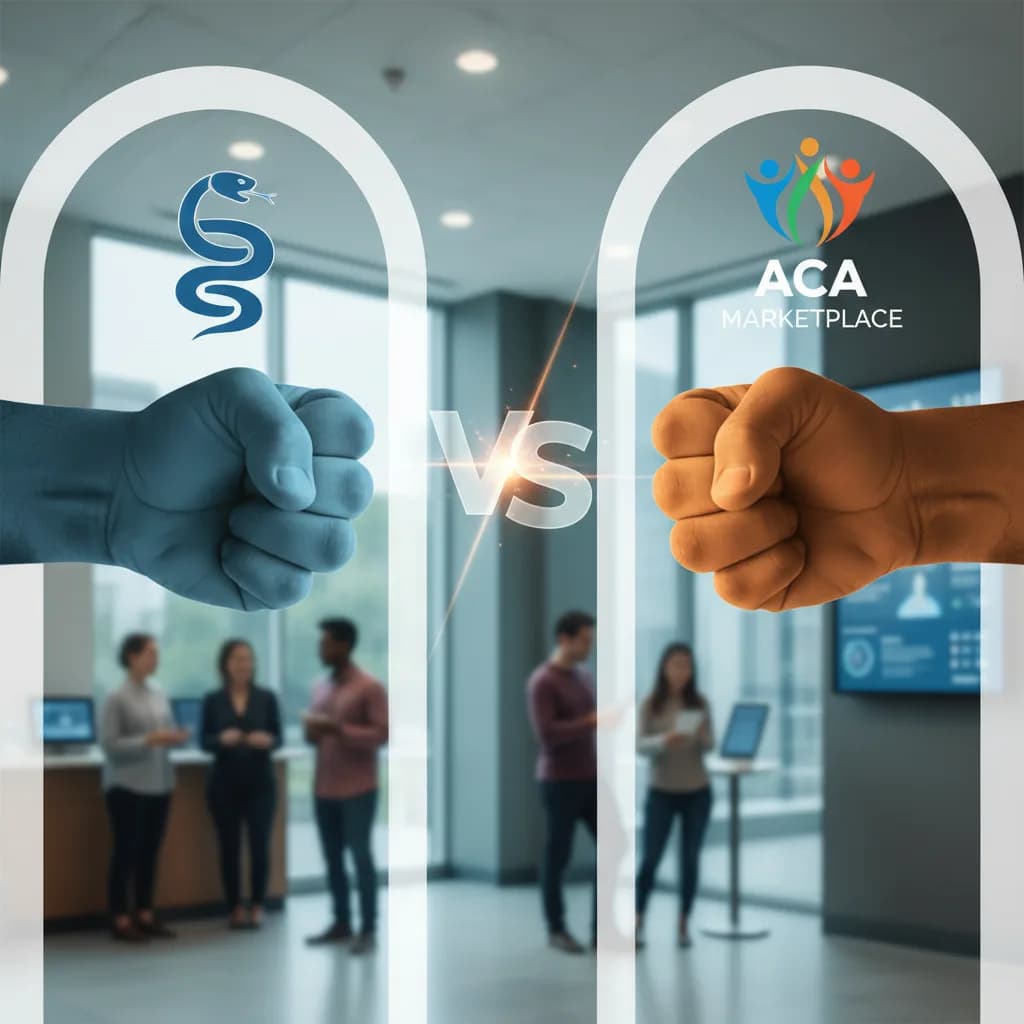COBRA vs. Marketplace: The Rematch 🥊 2025 Edition
Feeling that full-price COBRA pinch? Let’s compare your real options before you throw in the towel 💸🧮
🔍 The Real Story
- COBRA lets you keep the same employer plan after a qualifying event, but you typically pay the full premium plus up to a 2% administrative fee. U.S. DOL
- The Marketplace may offer alternatives, and you may qualify for premium tax credits (PTCs) that can lower monthly costs and cost-sharing reductions (CSRs) that may reduce deductibles and copays. Eligibility rules apply. HealthCare.gov
- If you’re covered by COBRA, PTCs generally aren’t available for those same months. If you’re offered COBRA but do not enroll, you can apply for Marketplace coverage right away if otherwise eligible. HealthCare.gov
⚙️ What’s New for 2025
- Enhanced Marketplace subsidies continue through 2025: Under the Inflation Reduction Act, eligible households see the benchmark Silver plan capped at up to 8.5% of household income. KFF
- The “family glitch” fix remains in effect: Since 2023, more spouses and dependents may qualify for Marketplace help if employer family coverage is considered unaffordable, even when employee-only coverage is affordable. U.S. Treasury/IRS
- Extra wiggle room for some: In states that use HealthCare.gov, people with incomes up to 150% FPL may have a Special Enrollment Period available throughout the year while enhanced subsidies are in place. Check your state-based Marketplace rules. KFF
👩👨👧 What It Means for You
- Cost check: COBRA can be a fit if you’re mid-treatment and need that exact network or drug formulary. For others, Marketplace plans with PTCs may cost less. Run both prices—don’t guess. HealthCare.gov
- Timing matters: After losing job-based coverage, you typically have 60 days to enroll in a Marketplace plan. If you pick COBRA, switching later usually must wait for Open Enrollment or when COBRA ends. Ending COBRA early generally doesn’t create a Special Enrollment Period. HealthCare.gov
- Deductibles: Switching mid-year usually resets deductibles and out-of-pocket maximums. Some carriers may credit amounts in limited cases—confirm before you move.
- Subsidy basics: PTCs are based on household size and MAGI for the tax year. You reconcile using IRS Form 8962—estimate income carefully to avoid owing back some credits. IRS, HealthCare.gov
🤝 Broker Insights (For the pros in your corner)
- Do the math: Compare the full COBRA premium (often 102% of total cost) to a benchmark Silver plan with estimated PTCs. Note assumptions and caveats. DOL
- Verify eligibility blockers: Check for other minimum essential coverage (Medicare, affordable employer plan, active COBRA) that could affect PTC eligibility. IRS Pub 974
- Network triage: If must-keep providers or meds aren’t in Marketplace networks/formularies, COBRA may still be the practical choice.
- Calendar discipline: Track the 60-day window after loss of coverage, the 60-day window before COBRA ends, and Open Enrollment dates. HealthCare.gov
- CSR awareness: For incomes 100–250% FPL, Silver plans with CSRs can offer lower cost-sharing than Bronze in many cases. HealthCare.gov
✅ Smart Next Steps
- Price both paths: Get the exact COBRA premium schedule and run a Marketplace quote with your best income estimate.
- Check doctors and meds: Confirm networks and formularies before switching—no surprise bills.
- Mind the taxes: Track projected income and save Marketplace notices to reconcile with Form 8962.
- Set reminders: If you’re on COBRA, set alerts for Open Enrollment and 60 days before COBRA ends.
- Ask a licensed pro: A licensed agent can help compare options and outline trade-offs so you can decide with confidence.
Sources
- U.S. Department of Labor – An Employee’s Guide to Health Benefits under COBRA: https://www.dol.gov/sites/dolgov/files/EBSA/about-ebsa/our-activities/resource-center/publications/an-employees-guide-to-health-benefits-under-cobra.pdf
- HealthCare.gov – COBRA coverage and Marketplace options: https://www.healthcare.gov/unemployed/cobra-coverage/
- HealthCare.gov – Special Enrollment Periods: https://www.healthcare.gov/coverage-outside-open-enrollment/special-enrollment-period/
- HealthCare.gov – See plans and prices: https://www.healthcare.gov/see-plans/
- HealthCare.gov – Income and household size: https://www.healthcare.gov/income-and-household-information/income/
- HealthCare.gov – Lower costs (PTCs and CSRs): https://www.healthcare.gov/lower-costs/
- IRS – About Form 8962 (Premium Tax Credit): https://www.irs.gov/forms-pubs/about-form-8962
- IRS/Treasury – Final rule addressing the “family glitch”: https://home.treasury.gov/news/press-releases/jy1032
- KFF – ARP/IRA Marketplace subsidy expansions through 2025: https://www.kff.org/health-reform/issue-brief/the-american-rescue-plans-expansions-of-marketplace-subsidies-expanded-coverage-and-lowered-costs-will-they-continue/
- KFF – Explaining health insurance subsidies and low-income SEP context: https://www.kff.org/health-reform/issue-brief/explaining-health-care-reform-questions-about-health-insurance-subsidies/
The Marketplace Hotline is a marketing platform and not a government program. We connect individuals and brokers with licensed insurance professionals. We are not connected with or endorsed by the U.S. Government or the federal Medicare program. This content is educational, not legal advice.
